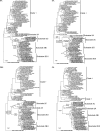Genetic makeup of amantadine-resistant and oseltamivir-resistant human influenza A/H1N1 viruses
- PMID: 20129961
- PMCID: PMC2849588
- DOI: 10.1128/JCM.01532-09
Genetic makeup of amantadine-resistant and oseltamivir-resistant human influenza A/H1N1 viruses
Abstract
The emergence and widespread occurrence of antiviral drug-resistant seasonal human influenza A viruses, especially oseltamivir-resistant A/H1N1 virus, are major concerns. To understand the genetic background of antiviral drug-resistant A/H1N1 viruses, we performed full genome sequencing of prepandemic A/H1N1 strains. Seasonal influenza A/H1N1 viruses, including antiviral-susceptible viruses, amantadine-resistant viruses, and oseltamivir-resistant viruses, obtained from several areas in Japan during the 2007-2008 and 2008-2009 influenza seasons were analyzed. Sequencing of the full genomes of these viruses was performed, and the phylogenetic relationships among the sequences of each individual genome segment were inferred. Reference genome sequences from the Influenza Virus Resource database were included to determine the closest ancestor for each segment. Phylogenetic analysis revealed that the oseltamivir-resistant strain evolved from a reassortant oseltamivir-susceptible strain (clade 2B) which circulated in the 2007-2008 season by acquiring the H275Y resistance-conferring mutation in the NA gene. The oseltamivir-resistant lineage (corresponding to the Northern European resistant lineage) represented 100% of the H1N1 isolates from the 2008-2009 season and further acquired at least one mutation in each of the polymerase basic protein 2 (PB2), polymerase basic protein 1 (PB1), hemagglutinin (HA), and neuraminidase (NA) genes. Therefore, a reassortment event involving two distinct oseltamivir-susceptible lineages, followed by the H275Y substitution in the NA gene and other mutations elsewhere in the genome, contributed to the emergence of the oseltamivir-resistant lineage. In contrast, amantadine-resistant viruses from the 2007-2008 season distinctly clustered in clade 2C and were characterized by extensive amino acid substitutions across their genomes, suggesting that a fitness gap among its genetic components might have driven these mutations to maintain it in the population.
Figures


References
-
- Baranovich, T., R. Saito, Y. Suzuki, H. Zaraket, C. Dapat, I. Caperig-Dapat, T. Oguma, I. I. Shabana, T. Saito, and H. Suzuki. 2010. Emergence of H274Y oseltamivir-resistant A(H1N1) influenza viruses in Japan during the 2008-2009 season. J. Clin. Virol. 47:23-28. - PubMed
-
- Bright, R. A., M. J. Medina, X. Xu, G. Perez-Oronoz, T. R. Wallis, X. M. Davis, L. Povinelli, N. J. Cox, and A. I. Klimov. 2005. Incidence of adamantane resistance among influenza A (H3N2) viruses isolated worldwide from 1994 to 2005: a cause for concern. Lancet 366:1175-1181. - PubMed
-
- Caton, A. J., G. G. Brownlee, J. W. Yewdell, and W. Gerhard. 1982. The antigenic structure of the influenza virus A/PR/8/34 hemagglutinin (H1 subtype). Cell 31:417-427. - PubMed
-
- Centers for Disease Control and Prevention. 2009. VRPBAC meeting briefing materials. Centers for Disease Control and Prevention, Atlanta, GA. http://www.fda.gov/ohrms/dockets/ac/09/briefing/2009-4416B1-1.pdf. Accessed 5 May 2009.
Publication types
MeSH terms
Substances
Associated data
- Actions
- Actions
- Actions
- Actions
- Actions
- Actions
- Actions
- Actions
- Actions
- Actions
- Actions
- Actions
- Actions
- Actions
- Actions
- Actions
- Actions
- Actions
- Actions
- Actions
- Actions
- Actions
- Actions
- Actions
- Actions
- Actions
- Actions
- Actions
- Actions
- Actions
- Actions
- Actions
- Actions
- Actions
- Actions
- Actions
- Actions
- Actions
- Actions
- Actions
- Actions
- Actions
- Actions
- Actions
- Actions
- Actions
- Actions
- Actions
- Actions
- Actions
- Actions
- Actions
- Actions
- Actions
- Actions
- Actions
- Actions
- Actions
- Actions
- Actions
- Actions
- Actions
- Actions
- Actions
- Actions
- Actions
- Actions
- Actions
- Actions
- Actions
- Actions
- Actions
- Actions
- Actions
- Actions
- Actions
- Actions
- Actions
- Actions
- Actions
- Actions
- Actions
- Actions
- Actions
- Actions
- Actions
- Actions
- Actions
- Actions
- Actions
- Actions
- Actions
- Actions
- Actions
- Actions
- Actions
- Actions
- Actions
- Actions
- Actions
- Actions
- Actions
- Actions
- Actions
- Actions
- Actions
- Actions
- Actions
- Actions
- Actions
- Actions
- Actions
- Actions
- Actions
- Actions
- Actions
- Actions
- Actions
- Actions
- Actions
- Actions
- Actions
- Actions
- Actions
- Actions
- Actions
- Actions
- Actions
- Actions
- Actions
- Actions
- Actions
- Actions
- Actions
- Actions
- Actions
- Actions
- Actions
- Actions
- Actions
- Actions
- Actions
- Actions
- Actions
- Actions
- Actions
- Actions
- Actions
- Actions
- Actions
- Actions
- Actions
- Actions
- Actions
- Actions
- Actions
- Actions
- Actions
- Actions
- Actions
- Actions
- Actions
- Actions
- Actions
- Actions
- Actions
- Actions
- Actions
- Actions
- Actions
- Actions
- Actions
- Actions
- Actions
- Actions
- Actions
- Actions
- Actions
- Actions
- Actions
- Actions
- Actions
- Actions
- Actions
LinkOut - more resources
Full Text Sources
Medical
Research Materials
Miscellaneous

